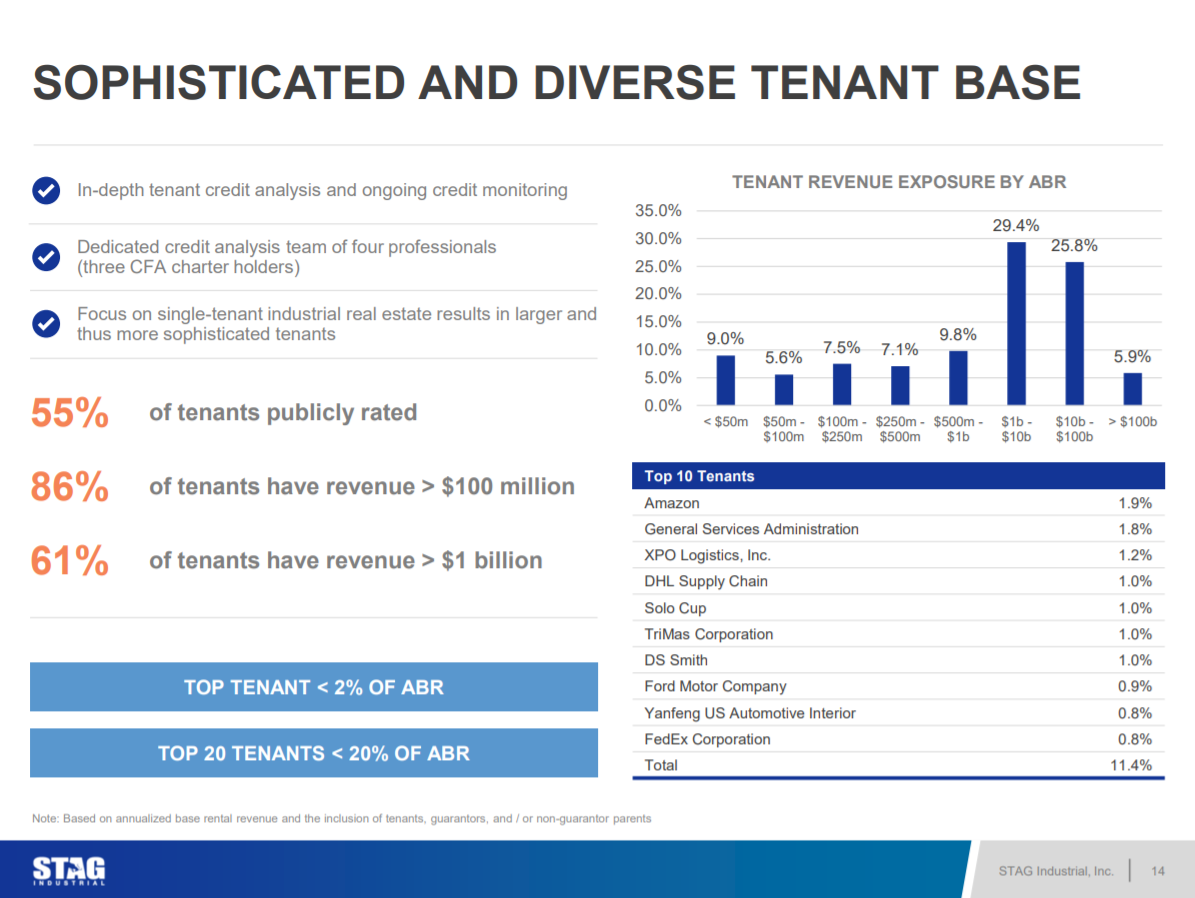Updated on March 3rd, 2020 by Josh Arnold
For investors seeking yield, the real estate industry is a great place to look. Intuitively, this is not surprising. Real estate owners collect predictable income from their tenants. Thus, the real estate business is qualitatively geared for business owners that want to collect periodic income.
This characteristic extends to real estate stocks as well. One of the best ways for investors to gain exposure to the real estate industry is through real estate investment trusts – or REITs, for short. REITs are required by law to pass the majority of their income to shareholders as dividends.
STAG Industrial (STAG) is a commercial REIT that focuses on leasing single-tenant industrial properties throughout the US. The trust’s shares had risen substantially into February, but have since pulled back by approximately ~20%. As such, shares once again look attractive.
The stock’s current dividend yield of 5% is nearly 3x as high as the average yield in the S&P 500. You can see the full list of 5%+ yield stocks here.
Further, STAG Industrial pays monthly dividends (rather than quarterly). This is highly beneficial for retirees and other investors who rely on their dividend income to cover life’s expenses. There are currently around 58 monthly dividend stocks.
You can download our full Excel spreadsheet of all monthly dividend stocks (along with metrics that matter like dividend yield and payout ratio) by clicking on the link below:
Because of the trust’s high yield and monthly dividend payments, STAG Industrial has the potential to be a great investment for income-oriented investors, particularly since the valuation has recently improved.
In addition, we see moderate levels of growth in the future, combined with a reasonably-priced stock, making for an attractive total return outlook over the next five years.
Business Overview
STAG Industrial is a REIT that specializes in industrial commercial real estate. The trust became publicly-traded in 2011 after spinning off from its predecessor, STAG Capital Partners, which was formed in 2004. Since the IPO, STAG Industrial has grown substantially – from 105 buildings initially to its current asset base of 450 buildings in 38 states rented to nearly 400 tenants.
The trust focuses on warehousing, distribution, and manufacturing facilities. This gives STAG a natural tailwind from the rise of e-commerce as retailers expand their warehousing and distribution operations to meet digital demand; STAG is there to lease these facilities. Indeed, STAG’s competitive advantage over other REITs is this focus on industrial properties that benefit from the ever-rising demand for warehousing.
More details about STAG Industrial’s current business model and strategy can be seen below.
Source: STAG Industrial Investor Presentation, slide 3
The trust specializes in owning and operating single-tenant industrial real estate properties.
Some REITs view single-tenant properties as risky because the properties are viewed as a binary proposition; they are either fully leased or empty. STAG states 43% of its portfolio is used for e-commerce fulfillment, a number that continues to grow.
However, focusing on single-tenant properties creates mispriced assets, which STAG can then add to their portfolio at attractive valuations. This is central to STAG’s strategy and is a key differentiator among competitors. In addition, STAG sees a continued rise in e-commerce as a percentage of retail sales as central to its strategy, as seen below.
Source: STAG Industrial Investor Presentation, slide 10
STAG’s addressable market is in excess of $1 trillion, half of which is made up of single tenant properties. The sector is highly fragmented, meaning that no particular entity would have a significant scale advantage. This is why STAG believes it can purchase mispriced assets.
STAG finds this to be an attractive mix of assets and combined with relatively low capex and high retention rates, it has created a strong portfolio of industrial real estate.
STAG’s tenant profile reflects the vast diversification it has built into its portfolio, which the trust believes diversifies away much of the risk of owning single tenant properties. The trust has almost 400 entities among its tenants and more than 60% of those tenants have at least $1 billion in annual revenue.
These are very large companies that presumably would better weather economic downturns and thus, would have the ability to continue to pay their rent under most economic conditions. STAG has done a nice job of taking a relatively risky sector of real estate – single tenant properties – and building a portfolio in such a way that it diversifies away much of that risk.
Growth Prospects
STAG Industrial’s growth since its IPO in 2011 has been impressive from both a fundamental and an investor return perspective. Fortunately, this real estate trust still has a strong growth runway.
STAG reported fourth quarter and full-year earnings on February 12th, and results were fairly strong. Core funds-from-operations, or FFO, rose 25% over the prior quarter on a dollar basis, but on a per-share basis, rose only 2% due to the continued issuance of new shares. The trust also grew its portfolio by 23 buildings for a total consideration of $456 million with an average capitalization rate of 6.1%. Further, the trust achieved an occupancy rate of 95%.
The trust continues to invest heavily in new properties as it expands its portfolio, and much of that financing is done with new common stock. We expect the trust will continue to issue new shares for the foreseeable future to expand its portfolio. However, it continues to grow its FFO more quickly than the share count, so the moves are still accretive to shareholders over time.
Looking ahead, STAG will likely continue to grow at a similar mid-single-digit rate. Indeed, we forecast 6% annual FFO-per-share growth in the next five years. The trust still has a very small market share in its target market of real estate assets, leaving plenty of room for expansion.
In addition, the trust has a very specific set of investment criteria it uses to find new properties, and it has shown both the willingness and ability to execute on its strategy.
Source: STAG Industrial Investor Presentation, slide 14
STAG has a highly-diversified tenant base with nearly the entire portfolio comprised of tenants with at least $100 million in annual revenue. Further, the trust has very little exposure to any particular industry or tenant. Diversification will help shelter the trust from the impacts of the next economic downturn.
The market dynamics of the sector are favorable as well, and have improved meaningfully in recent years. Warehouse occupancy continues to rise and is currently in the area of 92%; STAG’s is 95%. Rising occupancy has coincided with rent growth of ~1% annually as well, creating two sizable tailwinds for FFO growth.
With continued adoption of digital selling channels from retailers, we expect these metrics to continue to move higher for the industry, and indeed STAG specifically. This will help support its growth case in the years to come.
Dividend Analysis
STAG’s dividend is obviously very important, as investors generally own REITs for their payouts. STAG’s payout has grown every year since its IPO, and stands today at $1.44 per share. However, growth since 2015 has been very slight, as the payout was $1.36 in that year, and has grown by just eight cents in the years since.
We do not see material growth in the dividend moving forward because STAG’s payout ratio, which currently stands at 76% of FFO-per-share, is still fairly high. We think STAG will produce very small increases for the foreseeable future as it works to decrease the odds a cut would be necessary during a downturn.
The current payout ratio is down significantly from previous levels near 100% as STAG has made a concerted effort to reduce the vulnerability of its dividend. That effort is still underway, however, so we see meaningful payout growth as unlikely in the near-term.
The current payout ratio, combined with what we see as mid-single-digit FFO-per-share growth in the coming years, should gradually improve the safety of STAG’s dividend. The trust has also made divestitures when pricing is favorable, an option it could turn to temporarily cover dividend shortfalls. In short, we think the 5% yield is fairly safe at this point.
Final Thoughts
STAG Industrial has two characteristics that will immediately appeal to income investors: a 5% dividend yield and regular monthly dividend payments. This REIT is still an attractive value at today’s price and yield.
In addition, we like the trust’s strategy for long-term growth in a sector of real estate that is sometimes ignored by investors because of its perceived riskiness. Thus, STAG Industrial makes a good potential addition to a high-yield portfolio because of its high dividend yield, monthly dividend payments, and leadership in the single-tenant industrial real estate market.
We see total returns approaching 10% after the recent selloff as the valuation is in line with fair value, the yield is 5%, and we expect 6% FFO-per-share growth annually. As such, we see STAG as very attractive today.








